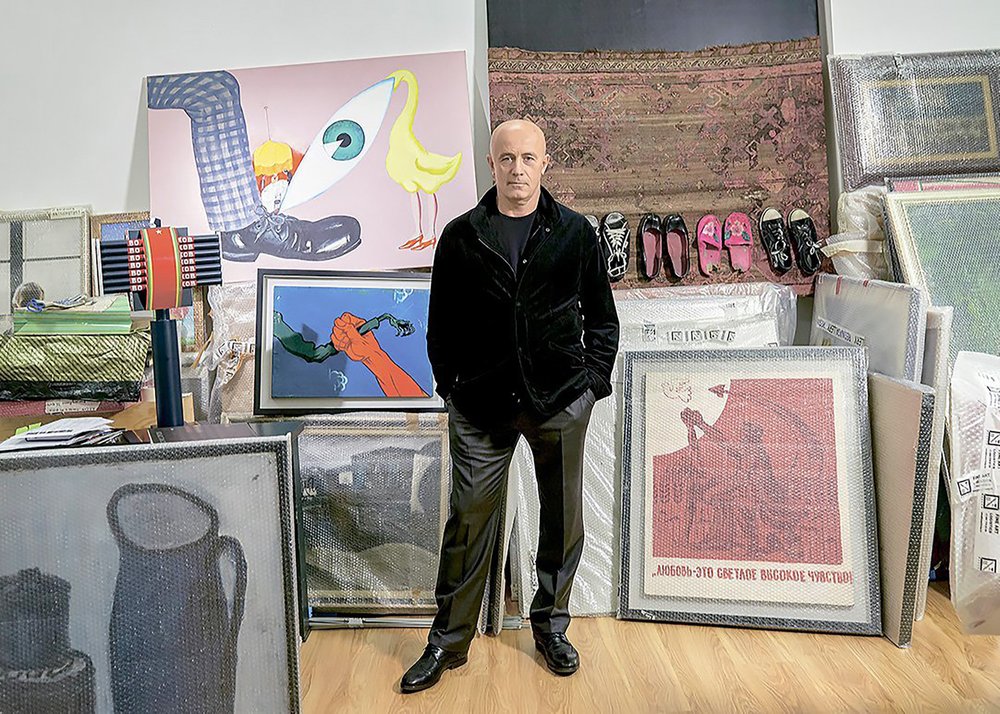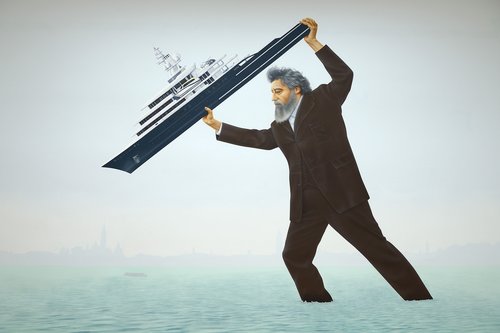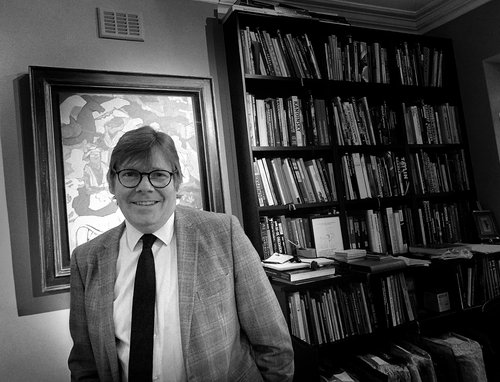Shalva Breus: in Pursuit of a Private Museum

Shalva Breus with works from his collection, 2019. Photo by Timur Anikeev. Courtesy of The Art Newspaper Russia
A leading player in the Russian art world of the 2000s, founder of the Kandinsky Prize and publisher of ‘Artchronika’ magazine, Shalva Breus admits that he once planned to create the most significant collection of contemporary art in Russia, and with Milena Orlova, Russian art critic, Editor-in-Chief of The Art Newspaper Russia, and former Editor-in-Chief of Artchronika, he shares his thoughts on what came of that dream and where he will go next.
Shalva Breus is an entrepreneur, publisher, collector, and president of the BREUS Foundation. He was born in Batumi, a city on the Black Sea shore in Soviet Georgia, in 1957 and graduated from the Economics Faculty of the Lomonosov Moscow State University in 1981. From 2006 till 2013 Breus published ‘Artchronika’ art magazine and in 2007 he founded the Kandinsky Prize, the most prestigious independent Russian national award for the contemporary arts. In 2014 Breus received the state Innovation award, an honorary prize ‘For Supporting Contemporary Art’. He is currently a member of the international jury of the Paris based Marcel Duchamp Prize in Contemporary Art and the Guerlain Prize in Contemporary Drawing. He is also a European Cup winner (1977) and USSR champion (1979) in water polo. He is married and has four children.
MO: Let us talk about your art collection which is admired and respected by art lovers and art professionals alike. Why did you suddenly decide to start collecting art, who put you up to it?
SB: I was born in the empire in Batumi, “in the remote provinces by the sea” (Ed. – a quote from Russian poet Joseph Brodsky). There were hardly any art books or none at all. We had one at home called ‘Fifty Western European Artists’ which had black-and-white illustrations, and my mother used to read it to me. I would also leaf through it on my own and knew it cover to cover, – I can still recite all the names of the artists in the book in right order: Giotto, Masaccio, Donatello, Leonardo, Botticelli, Raphael, Hans Holbein the Younger, Dürer and so on. When much later I found myself living in Moscow, I got to know a collector called Grigory Pavlovich Belyakov and in his small two-room flat, the walls were covered with masterpieces, they were even on the furniture. To get a wine glass out of a cupboard, he would have to take a painting down, open the door, close it, and put the painting back again. He taught me a lot, showed me things, and so, gradually, I became fascinated with art collecting, making all the mistakes new collectors make as they start out.
MO: So you bought fakes?
SB: I meant that back in the early 1990s there used to be a stereotypical path of a Russian collector: first you bought 19th century realist art, then you discovered the Silver Age, then modernism, and finally the avant-garde. I got over all that fairly quickly and moved on to other things.
MO: What was your first significant purchase?
SB: ‘Significant’ is a relative concept but probably ‘Dinner of Tiflis Merchants with Gramophone’ by Georgian modernist painter Niko Pirosmani. This is his only ‘banquet’ work which is not in a museum collection. Then there were many other important works, at least for me, including paintings by Western European artists. Mostly German and Austrian Expressionism: Oskar Kokoschka, Egon Schiele, ‘Die Brücke’, and ‘Der Blaue Reiter’ a very interesting range. The market was good for buyers then, prices hadn't yet soared. There are only three oil self-portraits by Schiele, two of which are in museums.
MO: And one is yours?
SB: I didn’t say that. Regarding Russian contemporary art: I did not understand it and was full of the typical prejudices of a layman: “they can't draw!”, “they’re only interested in shocking people!” and so forth. But paradoxically, my own inner circle included young artists. I was studying for my postgraduate degree, writing a dissertation on foreign policy, and was friends with Aidan Salakhova, Zhenya Mitta, Sasha Yakut, Gia Rigvava and others. They were a bit younger than me, and many of them dreamt of opening their own gallery, although statistically it was probably easier to become a cosmonaut in those days!. But they finally opened one called ‘The First Gallery’. After that closed down, Aidan opened her own ‘Aidan Gallery’, and Sasha Yakut opened ‘Yakut Gallery’. They were the true romantic pioneers. Everything was taking place in front of my own eyes, but I was a bit ironic towards their work. It did not touch me deeply; it seemed superficial to me. We were already publishing ‘ArtChronika’ magazine, the Kandinsky Prize already existed, but to be honest I was still ignoring contemporary Russian art. However, in 2010, at the Kandinsky Prize, I had a “system malfunction” in my head, and I bought ‘Zikr’, a project which had been chosen for the longlist of the main nomination by a remarkable artist called Aladdin Garunov. To my great regret, the project did not win the prize, but I wasn't disappointed, and ‘Zikr’ became the first step towards my own private collection of contemporary Russian art.
MO: So the prize you established helped you as a collector?
SB: I hope not just me. The prize helped break through the dam of conservatism that I had built within myself.
MO: As a result, you have become known as one of the largest collectors of Sots Art artists, if not the largest.
SB: Sots Art? Not really, yes it is true that I have a significant collection of Sots Art, but Sots Art does not have a special priority in our collecting strategy. If we are talking about Vitaly Komar and Alexander Melamid, the inventors of Sots Art, then my collection has more works from their ‘Anarchist Synthesism’ series, which I think is more universal.
MO: I’m speaking of ‘Sots Art’ in the broad sense, meaning unofficial Soviet artists of the 1970s.
SB: Who do you mean exactly? Rostislav Lebedev, Alexander Kosolapov to some extent, Komar and Melamid. Boris Orlov doesn't consider himself to be a Sots Artist. I remember talking with Viktor Pivovarov and Orlov, and Boris said: “They’ve stuck this Sots Art and Conceptualism on us, but we do transcendental art.” Pivovarov agreed with him. Also Leonid Sokov. I value his sculptural works highly. Of course, we have him in our collection.
MO: Besides these artists, what other areas in the field of contemporary Russian art do you collect?
SB: There is a period which I like to call the “Medici Period-2” where in a limited time and space, a galaxy of outstanding artists emerged each with their own independent, universal artistic language. Erik Bulatov, Boris Orlov, Grisha Bruskin, Mikhail Roginsky, Ilya Kabakov, Oleg Vasiliev, Ivan Chuikov, Viktor Pivovarov, and Vladimir Yankilevsky among others.
MO: But who were these Medici? Who supported them?
SB: In our case, the Soviet authorities played the role of the Medici. On the one hand, they gave artists studios and commissions for sustenance, but on the other hand, they also limited their possibilities and the resulting effect of this is that it doubled their energy. Plus, the fortuitous alignment of stars in the Soviet sky … otherwise I cannot really explain this phenomenon. Yes this is a joke, but it truly was a “Medici period” in terms of the sheer number of geniuses in close proximity to one another. They lived an intense intellectual life, had a deep knowledge of philosophy and art history, and selflessly sought their unique creative path. All of these names are represented in our collection.
MO: A few years ago, you wrote a story for The Art Newspaper Russia about how you bought Komar and Melamid’s work ‘Meeting of Alexander Solzhenitsyn and Heinrich Böll at Rostropovich’s Dacha’ at auction. This painting, estimated at €115,000, went for a record €634,000 – six times more expensive. Is this the most expensive work in your collection, a price record?
SB: We should separate value and price. Speaking of value, this work is, in my opinion, one of the most valuable paintings I have. According to art historians, it is the first postmodernist work in Russian art history. As for price, however much you pay for a masterpiece, it is still too little. Erik Bulatov costs more on the market.
MO: So, do you have quite a few works by Erik Bulatov?
SB: Sixteen paintings. In total, our collection has more than one thousand works, including art installations.
MO: Installations? Interesting. Not many collectors buy them.
SB: We do buy them and in fact our latest acquisition is ‘Where Is Our Place?’ an installation by Ilya Kabakov
MO: Fantastic! I remember it well when it was shown in Venice. A wonderful piece. But it is huge.
SB: Yes, it is truly on a museum-scale. I began negotiations to acquire it when Ilya was still alive. Emilia Kabakova helped us a lot, so the work finally entered our collection. Thinking back, I was so excited about it that I even wrote a page of text explaining why the installation should be in our collection.
MO: I imagine you must own an installation by Grisha Bruskin. You have done many exhibitions with them.
SB: ‘Archaeologist’s Collection’ and ‘Time CH’. We last showed ‘Time CH’ at a group exhibition of Kandinsky Prize winners at the Arsenal in Nizhny Novgorod in 2021. An hour before the opening, Grisha disappeared (we later learned, he had gone to the market of construction supplies) and returned with a coil of barbed wire. He separated the viewers from his sculptures with barbed wire, winding it around three steps where the figures were on display.
MO: Installations need to be stored somehow. They are not paintings that can be neatly stacked.
SB: Yes – I am thinking of Andrei Kuzkin’s masterpiece ‘Prayers and Heroes’ which consists of over a thousand tiny figures made from bread and four life-size busts made of bread soaked in the artist's blood. Before we bought it, we had many heated discussions with our art conservators. They tried to discourage me from acquiring it, understandably fearing insects and mice. Ideally, such works should be stored in a refrigerator and undergo quarantine. But we still went ahead and bought it.
Usually we give the artist technical specifications and ask that all parts of the installation be numbered, with technical instructions for assembly and disassembly. For example, we acquired two installations by Alexander Brodsky, and he had to provide us with this as part of our agreement.
MO: It’s like IKEA – assembly and disassembly instructions. How many installations do you have?
SB: At least six major ones!
MO: It seems to me that you have a rather masculine collection, macho art with lots of energy, even maybe warlike. I don’t think you have any female artists in your collection. Perhaps I’m wrong? I’m curious about what is important to you in the works you collect and why you have chosen them.
SB: Often more visible from the outside, questions of gender and politics, even socio-political aspects have no meaning for me. I guess this could be important curators working on a certain project or for a collector who has a specific theme. We very much love Olga Chernysheva and we have her works in the collection. We awarded the Kandinsky Prize in the main nomination to Irina Nakhova. Regarding politics, Emile Nolde once belonged to the Nazi Party, so should we exclude him from the world's largest museums and erase him from art history?
MO: Do you have some sort of expert council?
SB: Collection development and acquisitions are always discussed in the foundation among colleagues. We rarely buy emerging artists and we prefer to look mostly at artists who have already, shall we say, taken off from the runway. That is our current approach.
MO: How would you sum up your mission as a collector. Once the pieces of the puzzle come together what will one see?
SB: I used to have a radical vision of assembling one of the most significant collections of contemporary Russian art. Now our goal has changed: I have broadened the original focus, and now also collect art from the republics of the former USSR, Eastern European countries, and Western Asia, of course including Russia.
MO: Yes, that’s a cultural area, I understand. An interesting turn.
SB: For the global art scene, this is real terra incognita and there are amazing discoveries to be made for pioneers in the field. Within the framework of this more recent strategy, we are very active building up the existing collection. We now have artists from the Transcaucasian republics, Kazakhstan, Uzbekistan, Estonia and – by the way – Turkish art is very interesting. I am certain it will grow quickly.
MO: And Georgia, your homeland?
SB: Georgia, of course. Georgia, Armenia, Azerbaijan.
MO: A few years ago, you launched a series of monographs called the ‘New Classics’ about contemporary Russian art. Do you think there is insufficient academic understanding of our art?
SB: There is definitely a real and urgent need for more academic work to be done, although the ‘New Classics’ is a popular series not aimed at academics. Our society needs books about our leading contemporary artists which are written in an accessible language, yet without simplifying things or pandering to the reader. This series is designed not so much with professionals in mind but young people, art school students and the creative intelligentsia. For us, price accessibility is very important, so everyone can afford to buy them, whether a teacher from Krasnoyarsk or an engineer in Vladivostok.
MO: You have a big ambitions. Are there any other heroes?
SB: Yes, in the near future, ‘New Classics’ will publish a monograph on Ivan Chuikov. Then there will be Oleg Vasiliev, Vladimir Yankilevsky and Leonid Sokov. In the ‘Theory and History of Contemporary Art’ series, a book by 2017 Kandinsky Prize winner Alexander Borovsky, ‘Yankilevsky's Universe,’ is now ready to be published. We have long-term plans but we primarily want to publish books about artists of the older generation, to honour them within our modest means while they are still alive. Ilya Kabakov managed to see our book and, as far as we understood he liked it.
MO: These are all artists from your collection. Do you illustrate these books with works from your collection?
SB: We illustrate the books with the most important works by the artist that characterise their creativity and that are referred to in the book, mostly from museum collections. We do like to choose a work for the cover that comes from our collection if it is possible, a strong work that grabs people’s the attention. But if we do not have a suitable work, we find something else. The cover of the Kabakov book has a work which is not in our collection.
There is a need for academic publications, and we are planning a series of academic books, but there are not many writers capable of producing substantial academic material. As philosopher and art historian Evgeny Barabanov said, when you look at the science of art criticism in Russia, even the scientific toolkit is not fully developed. We use the terms like ‘nonconformists’, ‘Lianozovo group’ or ‘the conceptualists’, but the truth is that there is no clarity. More than half a century has passed, and we definitely need to introduce more concrete formulations into our scientific glossary, so that neither the reader nor the writer is confused. And this is only one part of a serious academic undertaking.
MO: You were planning to open a museum in the ‘Udarnik’ cinema in Moscow. That didn’t work out, but you've already made an enormous contribution by drawing attention to the fact that we have ‘Udarnik’ at all. Has the idea of a museum itself been preserved?
SB: Yes, I think there will be a museum. Two years ago, I acquired two hectares of land in the centre of Tbilisi. It is the building and territory of the former Mikhailovsky Hospital, built in the late 19th century. It is a blessed place: Pirosmani died there, and his grave has still not been found, and so did the famous poet of the late 19th and early 20th century, Alexander Kazbegi. We decided to hold an international competition to design the new museum building, the finalists included Pritzker Prize winners Jacques Herzog and Pierre de Meuron, Shigeru Ban and other world renowned architects.
MO: Who's building it in the end?
SB: Italian company Archea Associati who have built a major ceramics museum in China. Their project is now ready and engineering work is coming to an end so we hope construction can start this summer. Then comes the most important part – actually creating the museum not as a structure, but as a living creative organism.
This article was first published in Russian in the June 2025 issue of The Art Newspaper Russia.
















